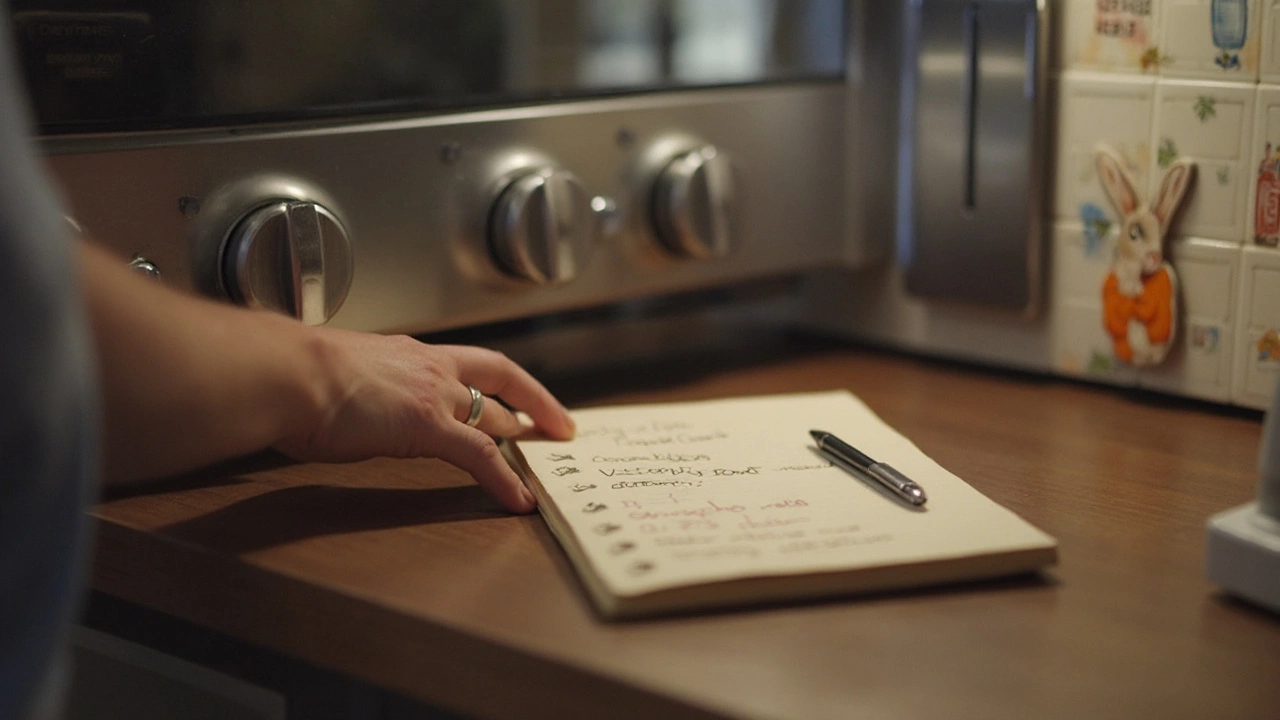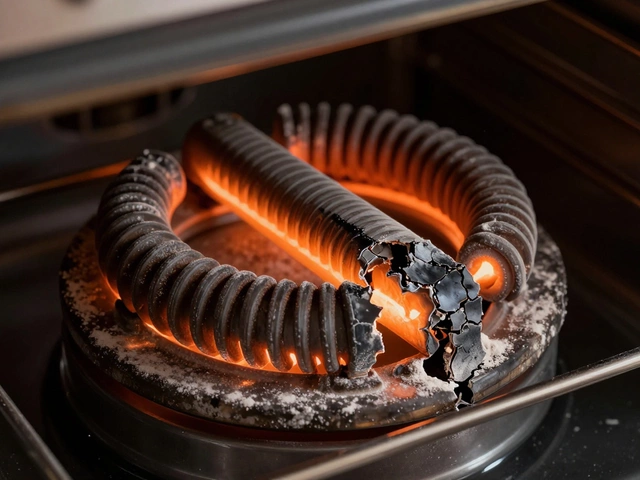When your electric oven doesn't work like it should, it can throw off your whole day—especially if you're hungry and dinner is waiting. Sometimes the problem is obvious, like if nothing heats up. Other times, it’s less clear: food comes out raw on one side and burned on the other, or the oven keeps making weird clicking noises you can’t ignore.
The thing is, most oven problems are pretty common and, once you know what to look for, you can deal with a lot before calling a repair person. That doesn’t mean you should poke around with a screwdriver unless you’re comfortable, but it helps to have a rough idea of what could be wrong.
If you’ve ever noticed Muffin (my dog) circling the oven, hoping for dropped snacks, you’ll know ovens get used a lot—and even the best ones wear out. The more you know about the usual faults, the better chance you’ve got at spotting issues early—before your next planned dinner party turns into a phone call for pizza delivery.
- Oven Won’t Heat Up
- Temperature Is All Over the Place
- Oven Door Problems
- Strange Smells and Noises
- When Electronics Go Haywire
- Repair or Replace? Making the Call
Oven Won’t Heat Up
If you turn your oven on and it just sits there cold as a fridge, you’re not alone. This is probably the most common complaint about electric oven faults. The frustrating part? It can come down to several things—some simple, some not.
The most frequent culprit is a busted heating element. In most electric ovens, you’ve got two: one at the top for broiling, one at the bottom for baking. If you don’t see them glowing red and no heat is coming out, there’s a good chance one’s dead. Visual cracks or burnt spots are pretty clear signs something’s up. Another simple thing to check is the power supply. If your oven’s clock is blank or the control panel isn’t lit, double-check the outlet and your circuit breaker.
Thermostat and temperature sensor issues are also at the top of the list. If the control board or sensor is faulty, the oven simply won’t know when to heat. Not all sensors are easy to test, but a digital multimeter can tell you if the sensor has failed if you’re into DIY.
- Check basics first: Power cord plugged in tight? No tripped circuit breaker?
- Peek inside: Are either of the heating elements visibly damaged or not glowing when cranked to high?
- Listen for clicks: If you hear repeated clicking but no heat, a relay or the control board might be shot.
- Try different settings: Bake, broil, convection—does anything work?
You might be surprised how much this issue comes up. A recent appliance service survey in the US said more than 30% of electric oven repair calls are for ovens failing to heat. That’s across all brands and price ranges. Here’s a quick table to show what usually causes the no-heat problem and how tricky each fix is:
| Cause | Easy to DIY? | Average Fix Cost (USD) |
|---|---|---|
| Tripped Breaker / Power Issue | Yes | $0–$50 |
| Burned Out Heating Element | Usually | $35–$120 |
| Faulty Temperature Sensor | Sometimes | $60–$180 |
| Broken Control Board | No | $200–$400 |
| Wiring Issues | No | $100–$300 |
If you’ve tried the easy stuff and nothing changes, it’s probably time to bring in a pro. Messing with high-voltage wiring or control boards isn’t worth the risk unless you know what you’re doing. But often, the fix is less scary than you’d think if you just start with the basics.
Temperature Is All Over the Place
Have you ever put something in your oven expecting it to bake evenly, but half is raw and the other half is nearly burnt? You’re not alone. Unstable oven temperature is a classic headache for anyone who owns an electric oven. This isn’t just annoying—it can totally ruin dinner plans and mess up your baking game.
The most common cause here is a faulty thermostat or temperature sensor. Ovens use these parts to check and control how hot they get. If they're off, so is your cooking. Some folks also find that a busted heating element causes hot and cold spots inside the oven. A cracked or broken door seal lets heat escape, making the oven work overtime in weird ways.
Here are a few symptoms that scream “temperature problems”:
- Food cooks faster or slower than usual even at the same temperature setting
- Baked goods come out unevenly browned
- Oven thermometer (if you have one) always disagrees with the display
- Strange burning smells during use
According to a recent survey by Appliance Repair Pros (2024), about 30% of all electric oven faults reported are linked to temperature issues. So, it’s not just you—this stuff happens to a lot of people!
| Common Culprit | DIY Fix Possible? | Extra Tools Needed |
|---|---|---|
| Faulty Thermostat | No | Needs professional |
| Broken Temperature Sensor | Maybe | Multimeter |
| Heating Element Burned Out | Yes | Screwdriver, gloves |
| Worn Door Seal | Yes | Replacement seal kit |
If you want to test your oven sensor at home, you can use a simple oven thermometer (not expensive) to double check: just set your oven to a temperature, let it heat, and see if the thermometer matches the display. If it’s more than 20°F off, you could have an internal problem. If fixing doesn't work, a pro is your best bet—some parts are cheap, but getting the diagnosis right is key unless you want to buy a whole new oven.
Oven Door Problems
It sounds silly, but a wonky oven door can ruin your cooking just as much as any busted heating element. If the door doesn't close right, you’ll lose heat fast, and what should be a crispy pizza turns into a soggy mess. A loose or warped door makes your electric oven faults list instantly. This isn’t just annoying—it messes with cooking times and even wastes energy.
The most common door problems? Jammed doors, broken hinges, faulty latches, and cracked glass panels. Sometimes you notice the door hanging unevenly, refusing to close tightly, or popping open slightly during cooking. Not only can this burn your hand (yep, been there), but the oven never reaches the temperature you set.
- Hinges: These wear out or bend, especially if someone likes to lean on the door. Swapping them isn’t rocket science, but getting the exact match for your model really matters.
- Seals and Gaskets: When the gasket around the edge gets brittle or torn, heat leaks out. Gaskets are cheap to replace and can make a night-and-day difference for your oven’s efficiency.
- Latches: Broken latches make self-cleaning impossible and might stop the door from closing, period. If your oven door won’t lock or unlock, this is probably the culprit.
- Glass Panels: Cracked inner glass shouldn’t be ignored since it can shatter under heat. That’s a mess (and a safety hazard) you don’t want.
If you’re curious, check this stat table about oven door issues:
| Common Issue | Average Fix Cost (USD) | DIY Difficulty |
|---|---|---|
| Door won’t close | $70-$150 | Medium |
| Broken hinge | $60-$120 | Medium |
| Damaged seal/gasket | $20-$50 | Easy |
| Cracked glass | $80-$200 | Hard |
Before calling a repair tech, double-check that nothing’s wedged in the door area (like a stuck pan rack). If the seal is dirty, sometimes just cleaning it improves the fit. But if the door keeps drooping or you spot a crack in the glass, it’s smart to stop using the oven until it’s fixed. Safety always comes first—nobody wants a glass explosion at 400°F.

Strange Smells and Noises
If your electric oven starts to give off odd smells or unexpected noises, don’t just shrug it off. These signs often hint at a real issue that could get worse—or even become unsafe—if you ignore them.
Let’s tackle smells first. A burning odor when you first use a new oven is usually normal. That’s just the protective coating or leftover oil from manufacturing burning off. But if you’ve had the oven a while and it reeks of burning plastic or strong chemicals, something’s up. You might have melted insulation on wiring, a stuck label, or food debris that slipped into a hot spot. Sometimes, faulty electrical parts can even give off a fishy or metallic smell—it’s worth checking before things get worse.
- If it smells like burning plastic, unplug the oven right away and check for melted wires or plastic items stuck inside.
- A greasy, burnt smell usually points to spilled food or accumulated grime. Ovens can collect a lot of it if you’re not cleaning regularly.
- Anything that smells like gas shouldn’t happen in electric ovens. If you notice it, double-check that you actually have an electric oven and not a hybrid, and call a professional to be safe.
Noises can be less obvious. An electric oven is never whisper-quiet, but certain sounds are red flags. A clicking noise that repeats could mean a failing relay switch or an issue with the control board. Banging, scraping, or rattling? Sometimes it’s just loose oven racks or a warped fan, but those can interfere with heating. Squealing often comes from a worn-out cooling fan or a convection motor that’s about to give out.
- Continuous clicking or rapid ticking while the oven is running—usually a sign of a faulty relay or control board problem.
- Loud rattling or scraping as the oven heats up—often caused by a loose or bent fan blade.
- Banging noises during preheat—sometimes happens if heating elements expand, but if it’s loud or repeats, check for mounting issues.
According to a consumer repair survey from 2023, about 22% of electric oven repairs were related to smells or sounds that wouldn’t go away. Addressing these early stopped bigger faults later on.
| Strange Sign | Most Common Cause | Recommended Action |
|---|---|---|
| Burning smell | Leftover food, wiring issue | Clean the oven, inspect for melted parts |
| Clicking noise | Relay switch, control board | Watch for power loss, call a pro if persistent |
| Squealing or whirring | Fan motor issue | Unplug and have the fan checked |
| Banging sound | Loose part or expanding metal | Secure loose parts, monitor frequency |
As a tip, run the oven empty after a deep clean before your next big meal. It lets you check for lingering smells or new noises in a low-stress situation. Sticking up for your senses is the fastest way to catch electric oven faults early.
When Electronics Go Haywire
Modern electric ovens rely on digital bits just as much as heating coils. When things like the control board, display, or sensors freak out, you’ll see it right away—maybe the oven won’t turn on, throws up an error code, or randomly shuts itself off in the middle of cooking. Sounds familiar? You’re not alone. A 2023 survey by Appliance Service News showed that electronic control failure was behind 22% of all electric oven repairs last year.
The control board is like the oven’s brain. It decides how long and how hot to run. If it gets fried or moisture seeps in, the results are all over the place. Your oven might ignore your temperature setting, flash random numbers on the display, or refuse to bake altogether. Common culprits for frying these boards? Power surges and steam from heavy-duty cleaning. If you’ve recently had a thunderstorm or noticed condensation inside the panel, this could be why your oven's acting up.
Here are typical electronic faults and what they look like:
- Display stops working: Sometimes it’s just a loose cable, but it can also be a dead display board. No numbers or programs means no way to set anything.
- Start button won’t do anything: Control board could be shot, or there’s a bad connection behind the panel.
- Error codes on the screen: Every code is a clue. For example, "F1" often means sensor fault, "F3" could be a temperature sensor or overheating. Check your oven’s manual for your model’s codes—they’re not all the same.
- Unresponsive temperature sensors: If your oven feels cool even when it claims it’s preheated, the sensor might be broken or not talking to the control board.
- Random shut-offs: If your oven just powers down while baking, electronics are the first thing to check. This can even be a safety feature tripped by faulty sensors.
It’s not just bad luck. Modern ovens are packed with more electronics than ever, and this extra complexity means more possible points of failure. If your oven is still under warranty, don’t mess with electronic parts yourself. Brands sometimes void the warranty if you try to fix it DIY-style.
If you want to try a simple reset, unplug the oven for ten minutes, then plug it in again. This sometimes clears out minor glitches—sort of like rebooting a computer. But if the problem comes back, you’re probably in for a replacement electronic part.
Here’s a quick look at which electronic faults are most common, where things go wrong most often:
| Fault Type | Percent of Cases (2024) |
|---|---|
| Control Board Failure | 13% |
| Display/Touchpad Issue | 6% |
| Temperature Sensor Fault | 5% |
| Other (Loose connections, resets) | 4% |
If you want your electric oven faults to be less likely, keep electronics dry by avoiding steam-heavy cleaning and consider a surge protector if power outages or storms are common in your area. Electronics might make ovens smarter, but they can sure cause headaches when they go haywire.
Repair or Replace? Making the Call
At some point, every electric oven shows its age. Maybe it’s blowing fuses, refusing to heat, or the door won’t close. The big question: Is it worth fixing, or should you just get a new one?
Start with some basics. If your oven is less than 8 years old, repairs usually make sense. Most issues—like a busted heating element or faulty thermostat—can be sorted out for less than $200. But if you’re looking at a control board problem, or your oven is more than 10 years old, costs can pile up quickly.
Here’s a simple way to decide:
- If repair costs are more than half the price of a new oven, it’s smart to think about a replacement.
- Replacement parts for popular models are easy to get, but some older brands or obscure models might require a repair shop to hunt for parts, which means more downtime and bigger bills.
- Energy bills gone up? Older electric ovens use up to 40% more electricity than some newer models. Sometimes, buying new means saving money long term.
Let’s break down common repair costs versus replacement:
| Problem | Average Repair Cost | Average Replacement Cost |
|---|---|---|
| Heating element | $100-200 | $600-2,000 for a new oven |
| Temperature sensor | $120-200 | " |
| Control board | $400-600 | " |
If you’re someone who cooks regularly, reliability matters. Hearing that repeated clicking, seeing random error codes, or dealing with uneven heating over and over is a sign you’ve crossed the line from "annoying" to "unreliable." When that happens, upgrading is usually less stress.
So, when should you pick up the phone for a electric oven faults repair, and when should you look for a shiny new model? If it’s a one-off problem, it’s probably fixable. If you’re stacking repair bills or wasting time waiting for parts, it might be time to move on. Also, check your warranty—they often cover parts and labor for several years.
Bottom line: Don’t let a broken oven ruin your week. Compare costs, think about age and reliability, and make the call that saves you time, money, and hassle in the long run.




